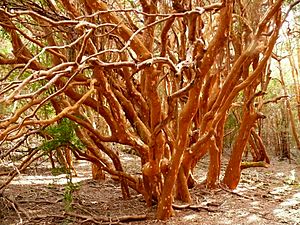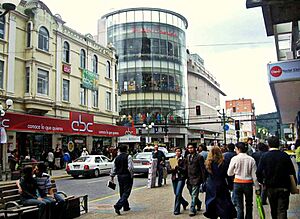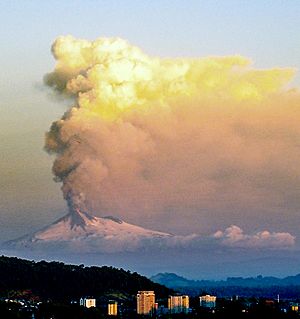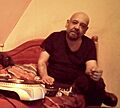Temuco facts for kids
Quick facts for kids
Temuco
|
|||||
|---|---|---|---|---|---|

View of Temuco from Cerro Ñielol
|
|||||
|
|||||
| Country | |||||
| Region | Araucanía | ||||
| Province | Cautín | ||||
| Founded | 24 February 1881 | ||||
| Government | |||||
| • Type | Municipality | ||||
| Area | |||||
| • Total | 464.0 km2 (179.2 sq mi) | ||||
| Elevation | 360 m (1,180 ft) | ||||
| Population | |||||
| • Total | 262,530 | ||||
| • Density | 565.80/km2 (1,465.41/sq mi) | ||||
| • Urban | 232,528 | ||||
| • Rural | 12,819 | ||||
| Demonym(s) | Temucan | ||||
| Sex | |||||
| • Men | 117,381 | ||||
| • Women | 128,348 | ||||
| Time zone | UTC−4 (CLT) | ||||
| • Summer (DST) | UTC−3 (CLST) | ||||
| Area code(s) | 56 + 45 | ||||
| Climate | Cfb | ||||
| Website | Official website: https://www.temuco.cl/ | ||||
Temuco is a city and commune in southern Chile. It is the capital of the Cautín Province and the Araucanía Region. The city is about 670 kilometers (416 miles) south of Santiago, Chile's capital.
Temuco started as a fort in 1881 during Chile's expansion into the Araucanía area. This region is the traditional home of the Mapuche people. Today, Temuco is a busy center for tourism, farming, and trade. It also has two big universities: University of the Frontier and Temuco Catholic University. Famous writers Gabriela Mistral and Pablo Neruda, both Nobel Prize winners, lived in Temuco for a time.
Contents
What Does the Name Temuco Mean?
The name "Temuco" comes from the Mapudungun language. It means "temu water." "Temu" is the name for two native trees from the Myrtaceae family: Luma apiculata (also called arrayán) and Blepharocalyx cruckshanksii.
These trees have reddish-orange bark. Their fruits and leaves are used by the Mapuche people for medicine. While Blepharocalyx cruckschankii is rare, Luma apiculata is common. You can see Luma apiculata trees in the Cerro Ñielol Natural Monument and in city gardens. The name "temu water" likely comes from these trees often growing near water.
A Look at Temuco's History
Temuco was founded as a military fort on February 24, 1881. This happened during the time Chile was expanding into the Araucanía region. Manuel Recabarren, who led the project, first named it Fuerte (Fort) Recabarren.
The city quickly grew from a military camp. By 1888, the first city leaders were elected, including the first mayor, José del Rosario Muñoz. In 1895, Temuco had 7,708 people. When Cautín became a province, Temuco was made its capital. By then, its population had grown to 16,037.
Temuco has a special connection to Chilean poetry. Nobel Prize winners Gabriela Mistral and Pablo Neruda (whose real name was Neftalí Reyes) both lived here. Gabriela Mistral was the principal of a girls' school. Pablo Neruda, when he was about 15, would visit her and share his first poems.
In 2010, a strong earthquake hit Chile on February 27. Temuco was one of the areas affected. The earthquake was very powerful, measuring 8.8 on the moment magnitude scale. Even though Temuco is inland, far from the ocean, it felt many strong aftershocks. One aftershock was 7.1 MW and happened about 70 kilometers (43 miles) northwest of the city.
Today, Temuco is a city that is growing fast. It has many different shops and services.
Who Lives in Temuco?
According to the 2002 census, Temuco had about 245,347 people. Most of them (94.8%) lived in urban areas, and a smaller number (5.2%) lived in rural areas. The city's population grew a lot between 1992 and 2002.
One unique thing about Temuco is the strong presence of the Mapuche culture. About 23.1% of the people in Temuco are Mapuche. This makes Temuco the city in Chile with the largest number of indigenous people. There are also many people of German background (9.8%).
People who live in Temuco are called temuquenses. They come from many different backgrounds. Many have Basque or Castilian (Spanish) ancestors. A large number of temuquenses are direct descendants of European immigrants. Many of these immigrants arrived between 1883 and 1901. They came mainly from Switzerland, Spain, France, Germany, Italy, and the United Kingdom.
Smaller groups of immigrants also came from other parts of Europe, like the Netherlands, Austria, Croatia, Armenia, Greece, and Portugal. Many arrived after the World Wars. During the Spanish Civil War in the 1930s, many people from different regions of Spain, such as Aragon, Asturians, Catalonia, Galicians, Navarrese, and Basques, moved to Temuco.
There are also small communities of Jewish people from Russia, Poland, Macedonia, Hungary, and other parts of Central and Eastern Europe. Additionally, there are Arab communities from Lebanon, Syria, and Palestine. These different groups have helped create the various clubs, schools, and areas you see in Temuco today.
After the Korean War in the 1950s, some East Asian communities, including Chinese, Japanese, and Koreans, also settled in Temuco.
Famous People from Temuco
Many notable people have connections to Temuco, including:
- Yanara Aedo, a professional football player.
- Gustavo Becerra-Schmidt, a composer.
- Rosa Catrileo, a member of the Constitutional Convention and a supporter of indigenous land rights.
- Fuad Chahín, a politician and former leader of the Christian Democratic Party.
- María José Ferrada, a children's author and journalist.
- Dagoberto Godoy, an aviator.
- Fabiola Letelier, a lawyer and human rights advocate.
- Pablo Neruda, who won the Nobel Prize in Literature in 1971.
- Leonor Oyarzún, a former first lady of Chile.
- Andrea Parra, a politician.
- Natalia Riffo, a politician and psychologist.
- Karina Riquelme Viveros, a human rights lawyer.
- Marcelo Salas, a retired football player and chairman of the local football club Deportes Temuco.
- Luis Salvadores Salvi, a Chilean basketball player.
- Raúl Sohr, a journalist, sociologist, and writer.
- Tanza Varela, an actress and model.
- Ena von Baer, a journalist and politician.
Where is Temuco Located?
Temuco is in a valley in the center-south of Chile. It is located about halfway between the Pacific Ocean to the west and the Andes mountains to the east. The city sits on land formed by the Cautín River. It is nestled between two hills, Ñielol (350 meters high) and Conunhueno (360 meters high).
Temuco's Economy and Environment
The area around Temuco has a typical landscape for central-southern Chile. You will see many tree plantations used for forestry, along with open grasslands. The original temperate forest of the area can mostly be found on the Ñielol hill.
A common problem in Temuco during autumn and winter is air pollution. This is because burning wood is the main way people heat their homes during the cold months. As a result, Temuco has the third lowest air quality in Chile.
What is Temuco's Climate Like?
Temuco has a climate that is similar to a Mediterranean climate (Köppen climate classification: Csb). This means it has distinct seasons. Summers are drier, but not as dry as in other central Chilean cities.
The average yearly temperature is about 13°C (55°F). The warmest month has an average high of 23.5°C (74.3°F), and the coldest month has an average low of 3.5°C (38.3°F). The average rainfall each year is about 1157 millimeters (45.6 inches).
| Climate data for Temuco (Maquehue Airport) 1991–2020, extremes 1952–present | |||||||||||||
|---|---|---|---|---|---|---|---|---|---|---|---|---|---|
| Month | Jan | Feb | Mar | Apr | May | Jun | Jul | Aug | Sep | Oct | Nov | Dec | Year |
| Record high °C (°F) | 38.0 (100.4) |
42.0 (107.6) |
35.1 (95.2) |
32.0 (89.6) |
24.1 (75.4) |
20.8 (69.4) |
20.7 (69.3) |
23.1 (73.6) |
26.8 (80.2) |
30.2 (86.4) |
34.4 (93.9) |
36.4 (97.5) |
42.0 (107.6) |
| Mean daily maximum °C (°F) | 25.0 (77.0) |
25.5 (77.9) |
23.0 (73.4) |
18.3 (64.9) |
14.6 (58.3) |
12.0 (53.6) |
11.7 (53.1) |
13.3 (55.9) |
15.5 (59.9) |
17.6 (63.7) |
19.7 (67.5) |
22.3 (72.1) |
18.2 (64.8) |
| Daily mean °C (°F) | 17.1 (62.8) |
17.3 (63.1) |
15.5 (59.9) |
12.4 (54.3) |
10.3 (50.5) |
8.5 (47.3) |
7.8 (46.0) |
8.7 (47.7) |
9.9 (49.8) |
11.6 (52.9) |
13.4 (56.1) |
15.4 (59.7) |
12.3 (54.1) |
| Mean daily minimum °C (°F) | 9.2 (48.6) |
9.0 (48.2) |
8.1 (46.6) |
6.5 (43.7) |
6.0 (42.8) |
4.9 (40.8) |
3.9 (39.0) |
4.2 (39.6) |
4.3 (39.7) |
5.7 (42.3) |
7.2 (45.0) |
8.5 (47.3) |
6.5 (43.7) |
| Record low °C (°F) | −0.2 (31.6) |
−1.9 (28.6) |
−2.0 (28.4) |
−4.0 (24.8) |
−5.4 (22.3) |
−6.9 (19.6) |
−8.1 (17.4) |
−6.7 (19.9) |
−4.3 (24.3) |
−3.0 (26.6) |
−2.4 (27.7) |
−0.2 (31.6) |
−8.1 (17.4) |
| Average precipitation mm (inches) | 27.8 (1.09) |
34.2 (1.35) |
43.8 (1.72) |
85.6 (3.37) |
148.0 (5.83) |
209.6 (8.25) |
156.7 (6.17) |
135.4 (5.33) |
86.4 (3.40) |
81.0 (3.19) |
57.3 (2.26) |
49.0 (1.93) |
1,114.8 (43.89) |
| Average precipitation days (≥ 1.0 mm) | 3.6 | 3.6 | 5.5 | 8.6 | 12.5 | 16.5 | 15.3 | 14.6 | 10.8 | 9.6 | 7.2 | 6.0 | 114.0 |
| Average relative humidity (%) | 72 | 72 | 77 | 83 | 87 | 88 | 87 | 84 | 81 | 79 | 78 | 75 | 80 |
| Mean monthly sunshine hours | 303.8 | 265.6 | 226.3 | 147.0 | 111.6 | 75.0 | 89.9 | 124.0 | 171.0 | 179.8 | 210.0 | 272.8 | 2,176.8 |
| Mean daily sunshine hours | 9.8 | 9.4 | 7.3 | 4.9 | 3.6 | 2.5 | 2.9 | 4.0 | 5.7 | 5.8 | 7.0 | 8.8 | 6.0 |
| Source 1: Dirección Meteorológica de Chile | |||||||||||||
| Source 2: NOAA (precipitation days 1991–2020), Universidad de Chile (sunshine hours only) | |||||||||||||
How Temuco is Governed
Temuco is a commune, which is a local government area in Chile. It is managed by a municipal council. The council is led by an alcalde (mayor), who is chosen by voters every four years. The mayor from 2008-2012 was Miguel Becker Alvear.
Temuco is part of Chile's political system. It is represented in the Chamber of Deputies (one of the two houses of the Chilean Congress) by two members. It is also represented in the Senate (the other house of Congress) by two members.
Sports in Temuco
Temuco is sometimes called "La ciudad del deporte," meaning "the city of sports." It has one of the newest and largest stadiums in Chile, called the "German Becker" stadium. This stadium is the home of the local soccer team, "Deportes Temuco."
The German Becker stadium has hosted many sports events, both local and international. These include:
- The FIFA U20 Women's World Cup in 2008.
- The WORLD RUGBY's U20 RUGBY WORLD TROPHY in 2013.
- The AMERICAN CUP in 2015.
Temuco was also one of the host cities for the official 1959 Basketball World Cup. In that tournament, the Chilean team won the bronze medal. Besides the stadium, Temuco has many gyms and parks where people can enjoy sports and recreation.
Getting Around Temuco
Buses and collective taxis are the most common ways to get around Temuco. A bus ride costs about CLP$150 for students and CLP$450 for adults. Collective taxis charge CLP$500, or CLP$650 at night.
La Araucanía Airport is the airport for Temuco. It is located south of the city, near the town of Freire, about 20 minutes away. A railroad connects Temuco to Victoria in the north and other towns in between. Temuco does not have a subway or light rail system.
Long-distance buses leave from the Terminal Rodoviario de la Araucania, which is at the north entrance to the city. Many people also use private cars, which can cause traffic jams during busy times.
Recently, more bike lanes have been built, making cycling a growing way to travel. By 2017, about 35 kilometers (22 miles) of bike lanes were expected to be open.
Important Places to Visit in Temuco
Temuco has several interesting places to explore:
Cerro Ñielol: A Natural Monument
The Ñielol Hill is home to the original temperate forest that covered this part of southern Chile before European settlement. Today, it is a protected area called a natural monument. It is also very important to the Mapuche people of the region. Near the top, there is a special ceremonial area called La Patagua. You can also find a restaurant and a viewpoint at the top of the hill, offering views of the east side of the city and Padre Las Casas. It's easy to reach by walking or driving. The Southern Andean Volcano Observatory has its office here.
Central Market: Crafts and Local Goods
The central market is a great place to find Mapuche crafts. It also has a meat market and shops selling items made from wood, wool, and other local goods. The original market building was recently damaged by a fire and is currently closed for reconstruction.
Feria Pinto: Fresh Produce Market
Feria Pinto is one of the most traditional spots in the city. Fresh fruits and vegetables are sold here every day. People from Temuco and nearby rural towns come here to buy and sell goods.
Alemania Avenue: A Busy Street

Alemania Avenue is a main road in Temuco. Here you can see the Araucaria Museum building, which shows 19th-century Chilean style. The Menchaca Lira Campus of Art Building, a recently restored Victorian-style building, is also on this avenue. The English Alley, with the Red Cross Building and a blue house (which was moved as a heritage project), also features Neoclassical styles.
Recently, Alemania Avenue has become a major shopping area. Many restaurants, nightclubs, pubs, pharmacies, boutiques, banks, supermarkets, and two shopping malls have opened there. There is also a casino and a five-star hotel on the avenue.
Anibal Pinto Square: The Heart of Downtown
The main square in downtown Temuco is called Anibal Pinto Square. It is unique because it's the only main square in Chile that doesn't have a water fountain in its center. Instead, an art gallery was built there in 1981 as part of a renovation. Compared to other main squares in southern Chile, Temuco's looks very modern. It has been called one of Chile's most beautiful plazas.
Traditionally, certain buildings are supposed to be around a main square in Chilean cities. In Temuco, this tradition has been changed a bit. The Cathedral and the Municipality building are in front of the square, as is traditional. There used to be a movie theater there. However, there is no fire station or school directly in front of the square. There are four banks around the main square.
Images for kids
See also
 In Spanish: Temuco para niños
In Spanish: Temuco para niños
















